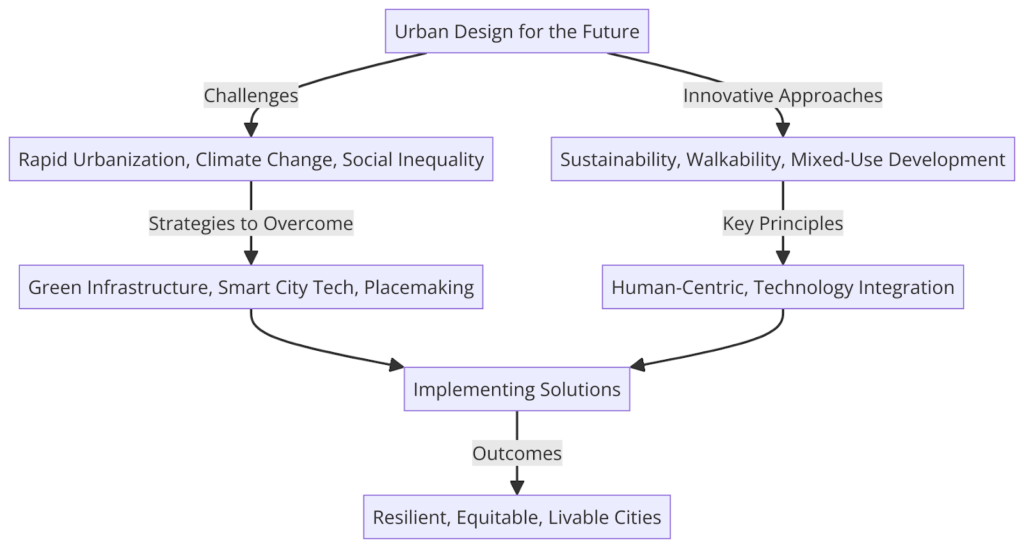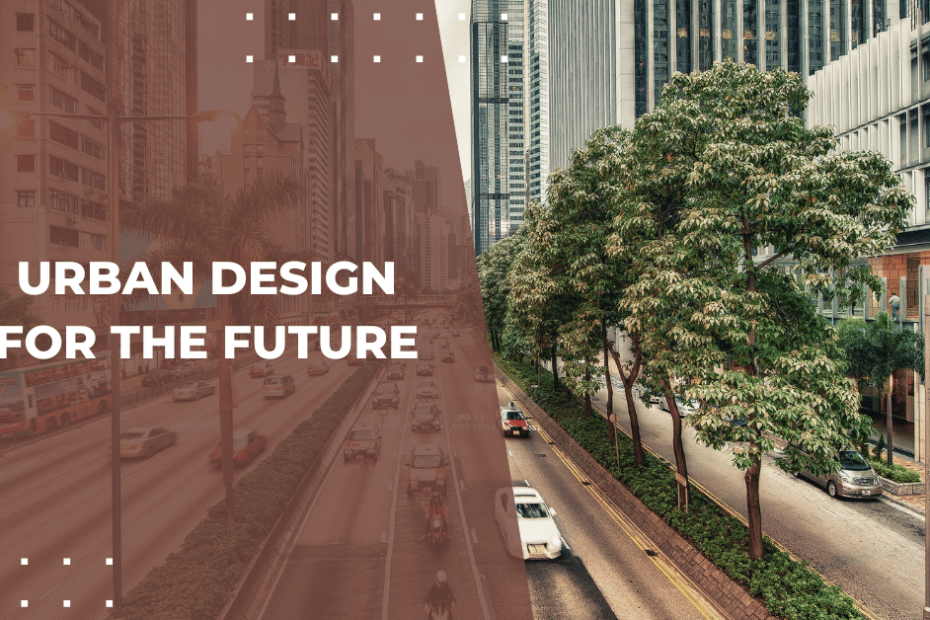Urban design plays a pivotal role in shaping the future of cities, determining not only their physical layout but also their social, economic, and environmental sustainability. It involves the thoughtful arrangement and design of buildings, public spaces, transportation systems, and amenities to create functional, attractive, and sustainable urban environments.
Urban planning faces numerous challenges, including rapid urbanization, climate change, and social inequality. However, these challenges also present opportunities to innovate and create cities that are more resilient, equitable, and livable. By embracing sustainable and inclusive design principles, urban planners can address these issues and enhance the quality of life for city dwellers.
This article aims to explore innovative approaches and strategies in urban design for the future. We will delve into the evolution of urban design, examine key principles for future-oriented planning, and discuss how cities can leverage these concepts to build vibrant and sustainable urban environments.
The Evolution of Urban Design
Historical Perspective
Urban design has evolved significantly over the centuries, from the grid layouts of ancient cities to the garden city movement of the early 20th century. Each era brought new ideas and challenges, shaping the way cities were planned and built. The rise of modernism and the subsequent reaction against it in the form of New Urbanism have both influenced contemporary urban design practices.
Modern Innovations
Contemporary urban design is characterized by a focus on sustainability, walkability, and mixed-use development. Innovations such as green infrastructure, smart city technologies, and placemaking initiatives are shaping modern urban landscapes. These trends reflect a shift towards creating more human-centered and environmentally friendly cities.
The Future Landscape
The future of urban design is expected to be influenced by emerging concepts and technologies such as autonomous vehicles, vertical gardens, and the Internet of Things (IoT). These advancements offer the potential to revolutionize urban living, making cities more efficient, resilient, and adaptable to the needs of their inhabitants.
Key Principles of Future-Oriented Urban Design
Sustainability and Resilience
Sustainable urban design is crucial for addressing environmental challenges and ensuring the long-term viability of cities. This involves incorporating green spaces, renewable energy sources, and sustainable materials into city planning. Resilience planning is also essential for preparing cities to withstand and recover from natural disasters and climate change impacts.
Human-Centric Approach
A human-centric approach to urban design prioritizes the well-being and needs of residents. This means creating safe, accessible, and inclusive spaces that promote social interaction and community engagement. Designing cities with a focus on pedestrian-friendly streets, public transportation, and affordable housing can enhance livability and social equity.
Technological Integration
Technology plays a key role in enhancing urban infrastructure and services. Smart city initiatives that integrate IoT devices, data analytics, and digital platforms can improve urban management and service delivery. By harnessing technology, cities can become more connected, efficient, and responsive to the needs of their citizens.
Implementing Effective Urban Design Strategies
Engaging Communities
Involving local communities in the urban design process is crucial for creating inclusive and responsive urban environments. Start by conducting public consultations and workshops to gather input and ideas from residents. Use participatory design techniques such as surveys, interactive mapping, and focus groups to ensure diverse voices are heard. Incorporating community feedback into design plans helps build a sense of ownership and ensures that the final outcomes meet the needs and aspirations of the people who live and work in the area.
Navigating Regulatory Challenges
Urban development projects often face a complex web of zoning laws and regulations. To navigate these challenges, it’s important to have a thorough understanding of local planning policies and guidelines. Engage with planning authorities early in the process to identify any potential issues and seek advice on compliance. Consider hiring legal and planning experts to assist with navigating the regulatory landscape and securing the necessary approvals for your project.
Leveraging Data and Analytics
Data-driven insights can significantly inform urban design decisions, leading to more effective and efficient outcomes. Utilize geographic information systems (GIS), urban modeling tools, and data analytics to analyze spatial patterns, demographic trends, and infrastructure needs. By harnessing the power of data, urban designers can make informed choices about land use, transportation networks, and public amenities, ultimately creating more sustainable and livable cities.
Paving the Path to Future Cities

The future of urban design is a complex puzzle that requires a harmonious blend of creativity, strategy, and technology. As we stand on the cusp of a new era in city planning, the challenges of rapid urbanization, climate change, and social inequality loom large. Yet, within these challenges lie unprecedented opportunities to redefine the essence of urban living. The diagram above offers a visual roadmap of how urban design can navigate these challenges, embracing innovative approaches and key principles to create cities that are not just habitable but thrive.
From Challenges to Opportunities
Rapid urbanization presents a double-edged sword, bringing economic growth and development on one side and congestion, pollution, and strained resources on the other. Climate change adds another layer of complexity, threatening the very fabric of urban life with extreme weather events and rising sea levels. Meanwhile, social inequality underscores the urgent need for inclusive design that bridges the gap between different segments of society. Together, these challenges form the battleground on which the future of urban design will unfold.
Innovative Approaches to Urban Design
In the face of these challenges, urban design is pivoting towards sustainability, walkability, and mixed-use development as pillars of modern city planning. Green infrastructure, smart city technologies, and placemaking initiatives emerge as transformative solutions, pointing towards a future where cities are built with an eye towards environmental stewardship, technological integration, and community engagement.
Key Principles for Future-Oriented Planning
At the core of these innovative approaches are the principles of human-centric design and technological integration. By prioritizing the well-being and needs of residents, cities can cultivate environments that promote social interaction, health, and happiness. Simultaneously, embracing technology as a tool for enhancing urban infrastructure and services ensures that cities are not just responsive to the needs of their citizens but also resilient in the face of change.
Implementing Solutions for Vibrant Urban Futures
The journey from concept to reality requires a concerted effort to implement these solutions effectively. Engaging communities in the urban design process ensures that the fabric of the city reflects the diverse tapestry of its inhabitants. Navigating regulatory challenges and leveraging data and analytics further streamline this process, turning visionary ideas into tangible outcomes.
The Vision of Resilient, Equitable, and Livable Cities
The ultimate goal of urban design is to forge cities that stand as bastions of resilience, equality, and livability. This vision encapsulates a future where urban environments are not just spaces of economic activity but sanctuaries of human experience—places where individuals can thrive in harmony with nature and one another.
5 Innovative Urban Design Projects Shaping the Future
1. Smart City Initiatives
Smart city initiatives are revolutionizing urban design by integrating technology into the fabric of cities. These projects use IoT devices, sensors, and data analytics to improve urban services and infrastructure. Examples include intelligent traffic management systems, smart lighting, and environmental monitoring. By leveraging technology, smart cities aim to enhance efficiency, sustainability, and quality of life for residents.
2. Green Infrastructure and Parks
Green infrastructure and parks play a vital role in urban design, providing ecological, social, and health benefits. Projects such as urban forests, green roofs, and rain gardens help manage stormwater, reduce urban heat island effects, and improve air quality. Parks and green spaces offer recreational opportunities and serve as community gathering places, contributing to the overall well-being of urban dwellers.
3. Pedestrian-Friendly Streetscapes
Designing pedestrian-friendly streetscapes is essential for promoting walkability and active transportation in cities. This involves creating safe, accessible, and attractive pedestrian pathways, incorporating features such as wide sidewalks, street trees, and benches. Prioritizing pedestrian comfort and safety encourages walking, reduces reliance on cars, and fosters vibrant street life.
4. Mixed-Use Developments
Mixed-use developments combine residential, commercial, and recreational uses in a single project, creating dynamic and diverse urban environments. These developments promote a live-work-play lifestyle, reducing the need for long commutes and enhancing the convenience and quality of urban living. By integrating different uses, mixed-use developments contribute to the vitality and sustainability of urban areas.
5. Adaptive Reuse Projects
Adaptive reuse projects involve repurposing existing buildings or sites for new uses, preserving historical structures while meeting contemporary needs. These projects can transform abandoned warehouses into creative workspaces, convert old factories into residential lofts, or turn historic buildings into cultural centers. Adaptive reuse not only conserves architectural heritage but also promotes sustainable development by reducing the need for new construction.
Implementing effective urban design strategies requires a multifaceted approach that involves engaging communities, navigating regulatory challenges, and leveraging data and analytics. By embracing innovative projects such as smart city initiatives, green infrastructure, pedestrian-friendly streetscapes, mixed-use developments, and adaptive reuse, urban designers can shape the future of cities, creating sustainable, inclusive, and vibrant urban environments.
The Role of Urban Design in Addressing Global Challenges
Climate Change and Urban Resilience
Urban design plays a crucial role in mitigating the impacts of climate change and enhancing city resilience. By incorporating green infrastructure, such as parks, green roofs, and permeable pavements, urban design can reduce heat island effects, improve air quality, and manage stormwater. Thoughtful planning and design of urban areas can also protect against sea-level rise and extreme weather events, ensuring that cities are better prepared to withstand and recover from climate-related challenges.
Urbanization and Housing
Rapid urbanization presents significant challenges for housing, with a growing demand for affordable and accessible living spaces. Urban design can address these challenges by promoting compact, mixed-use developments that optimize land use and reduce sprawl. By integrating affordable housing options into urban planning, cities can ensure that all residents have access to safe and decent housing, contributing to social equity and cohesion.
Public Health and Well-being
The connection between urban design and public health outcomes is increasingly recognized. Well-designed urban environments can promote physical activity, reduce exposure to pollution, and provide access to green spaces, which are essential for mental and physical well-being. Creating walkable neighborhoods, safe cycling infrastructure, and accessible public transportation can encourage active lifestyles and reduce the risk of chronic diseases.
Some FAQs Answered on The Relevant Topic
How does urban design impact environmental sustainability?
Urban design impacts environmental sustainability by influencing energy consumption, resource use, and ecological balance. Sustainable urban design practices, such as incorporating green spaces, using renewable energy sources, and promoting public transportation, can reduce the environmental footprint of cities and contribute to a healthier planet.
What is the significance of public spaces in urban design?
Public spaces are vital in urban design as they provide areas for social interaction, recreation, and cultural activities. Well-designed public spaces enhance the livability of cities, foster community engagement, and contribute to the overall quality of urban life. They also play a key role in the identity and character of a city.
How can cities balance development and preservation in urban design?
Cities can balance development and preservation in urban design by adopting a holistic approach that considers the historical, cultural, and environmental significance of areas. Implementing adaptive reuse strategies, establishing conservation districts, and integrating new developments sensitively into the existing urban fabric can ensure that growth and preservation go hand in hand.
What are the key considerations for designing cities for the future?
Key considerations for designing cities for the future include sustainability, resilience, inclusivity, and adaptability. Urban design should prioritize environmental protection, social equity, and economic vitality while being flexible enough to accommodate changing needs and technologies. Engaging with communities and stakeholders is also essential for creating cities that reflect the diverse needs and aspirations of their inhabitants.
In conclusion, urban design plays a pivotal role in addressing global challenges such as climate change, urbanization, and public health. By embracing innovative and inclusive design principles, cities can create sustainable, resilient, and livable environments that meet the needs of present and future generations. As we look to the future, the importance of thoughtful and forward-thinking urban design in building vibrant and thriving cities cannot be overstated.

Thomas J. Powell is the Senior Advisor at Brehon Strategies, a seasoned entrepreneur and a private equity expert. With a career in banking and finance that began in 1988 in Silicon Valley, he boasts over three and a half decades of robust experience in the industry. Powell holds dual citizenship in the European Union and the United States, allowing him to navigate international business environments with ease. A Doctor of Law and Policy student at Northeastern University, he focuses on middle-income workforce housing shortages in rural resort communities. He blends his professional acumen with a strong commitment to community service, having been associated with the Boys and Girls Clubs of America for over 45 years. Follow Thomas J Powell on LinkedIn, Twitter,Crunchbase.

